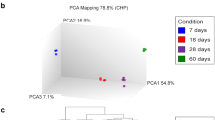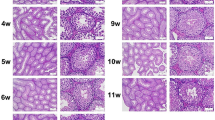Abstract
Temporal gene expression profiling can provide valuable insight into mechanisms of differentiation and may be helpful in laying a foundation for characterization of the molecular aspects of development. Prostate development begins in fetal life and is complete at sexual maturity, and androgen stimulation is both necessary and sufficient for development and maturity of the prostate. In this study, we investigated gene expression profiles of rat prostate at 3 different developmental stages (2 weeks, 3.5 weeks, and 8 weeks), when serum testosterone levels are low, intermediate, and high. Through this analysis, we attempted to narrow down genes whose expression is affected by androgen increase during pubertal growth and maturation of the prostate.
Similar content being viewed by others
References
Lau KM, Tam NN, Thompson C, Cheng RY, Leung YK, Ho SM. Age-associated changes in histology and gene-expression profile in the rat ventral prostate. Lab Invest. 2003;83(5):743–757.
Takeshi K, Roanna TM, Alea AM, Gerald RC. Role of p63 and basal cells in the prostate. Differentiation. 2004;131(20):4955–4964.
Timms BG. Prostate development: a histological perspective. Differentiation. 2008;76(6):565–577.
Cook C, Vezina CM, Allgeier SH, et al. Noggin is required for normal lobe pattering and ductal budding in the mouse prostate. Dev Biol. 2007;312(1):217–230.
Sugimura Y, Cunha GR, Donjacour AA. Morphogenesis of ductal networks in the mouse prostate. Biol Reprod. 1986;34(5):961–971.
Huang L, Pu Y, Hu WY, et al. The role of Wnt5a in prostate gland development. Dev Biol. 2009;328(2):188–199.
Hayward SW, Cunha GR. The prostate: development and physiology. Radiol Clin North Am. 2000;38(1):1–14.
Prins GS, Birch L. The developmental pattern of androgen receptor expression in rat prostate lobes is altered after neonatal exposure to estrogen. Endocrinology. 1995;136(3):1303–1314.
Pritchard CC, Nelson PS. Gene expression profiling in the developing prostate. Differentiation. 2008;76(6):624–640.
Prins GS, Birch L, Greene GL. Androgen receptor localization in different cell types of the adult rat prostate. Endocrinology. 1991;129(6):3187–3199.
Chatterjee B. The role of the androgen receptor in the development of prostatic hyperplasia and prostate. Mol Cell Biochem. 2003;253(1–2):89–101.
Banerjee PP, Banerjee S, Brown TR. Increased androgen receptor expression correlates with development of aged-dependent, lobe-specific spontaneous hyperplasia of the brown Norway rat prostate. Endocrionology. 2001;142(9):4066–4075.
Waltregny D, Leav I, Signoretti S, et al. Androgen-driven prostate epithelial cell proliferation and differentiation in vivo involve the regulation of p27. Mol Endocrionol. 2001;15(5):765–782.
Jeong BC, Honh CY, Chattopadhyay S, et al. Androgen receptor corepressor-19kDa (ARR19), a leucine-rich protein that represses the transcriptional activity of androgen receptor through recruitment of histone deacetylase. Mol Endocrionol. 2004;18(1):13–25.
Gong EY, Park E, Lee HJ, Lee K. Expression of Atp8b3 in murine testis and its characterization as a testis specific P-Type ATPase. Reproduction. 2009;137(2):345–351.
Yoon CH, Miah MA, Kim KP, Bae YS. New Cdc2 Tyr 4 phosphorylation by daRNA-activated protein kinase triggers Cdc2 polyubiquitination and G2 arrest under genotoxic stresses. EMBO Rep. 2010;11(5):393–399.
Qiao M, Shapiro P, Fosbrink M, Rus H, Kumar R, Passaniti A. Cell cycle-dependent phosphorylation of the RUNX2 transcription factor by cdc2 regulates endothelial cell proliferation. J Biol Chem. 2006;281(11):7118–7128.
Prins GS, Putz O. Molecular signaling pathways that regulate prostate gland development. Differentiation. 2008;76(6):641–659.
O’Connor DS, Grossman D, Plescia J, et al. Regulation of apoptosis at cell division by p34cdc2 phosphorylation of survivin. Proc Natl Acad Sci U S A. 2000;97(24):12103–13107.
Ryu MS, Lee MS, Hong JW, et al. TIS21/BTG/PC3 is expressed through PKC-delta pathway and inhibits binding of cyclin B1-Cdc2 and its activity, independent of p53 expression. Exp Cell Res. 2004;299:159–170.
Han SJ, Conti M. New pathways from PKA to the Cdc2/cyclin B complex in oocytes: Wee1B as a potential PKA substrate. Cell Cycle. 2006;5(3):227–231.
Bhattacharya R, Cabral F. A ubiquitous β-tubulin disrupts microtubule assembly and inhibits cell proliferation. Mol Biol Cell. 2004;15(7):3123–3131.
Baik MG, Lee MJ, Choi YJ. Gene expression during involution of mammary gland. Int J Mol Med. 1998;2(1):39–44.
Leng L, Metz CN, Fang Y, et al. MIF signal transduction initiated by binding to CD74. J Exp Med. 2003;197(11):1467–1476.
Marsh LM, Cakarova L, Kwapiszewska G, et al. Surface expression of CD74 by type II alveolar epithelial cells: a potential mechanism for macrophage migration inhibitory factor-induced epithelial repair. Am J Physiol Lung Cell Mol Physiol. 2009;296(3):L442–L452.
Xavier F, Allard S. Anti-Mullerian hormone, beta-catenin and Mullerian duct repression. Mol Cell Endocrinol. 2003;211(1):115–121.
Wang Q, Li N, Wang X, et al. Membrane protein hMYADM preferentially expressed in myeloid cells is up-regulated during differentiation of stem cells and myeloid leukemia cells. Life Sci. 2007;80(5):420–429.
Mima S, Ushijima H, Hwang HJ, et al. Identification of the TPO1 gene in yeast, and its human othologue TETRAN, which cause resistance to NSAIDs. FEBS Lett. 2007;581(7):1457–1463.
Bain J. Andropause. Testosterone replacement therapy for aging men. Can Fam Physician. 2001;47:91–97.
Cyriac J, Haleem R, Cai X, Wang Z. Androgen regulation of spermidine synthase expression in the rat prostate. Prostate. 2002;50(4):252–261.
Balk SP, Knudsen KE. AR, the cell cycle, and prostate cancer. Nucl Recept Signal. 2008;6:e001.
Jiang F, Wang Z. Identification of androgen-responsive genes in the rat ventral prostate by complementary deoxyribonucleic acid and microarray. Endocrinology. 2003;144(4):1257–1265.
Nalbandian A, Pang AL, Rennert OM, Chan WY, Ravindranath N, Djakiew D. A novel function of differentiation revealed by cDNA microarray profiling of p75NTR-regulated gene expression. Differentiation. 2005;73(8):385–396.
Lam YW, Tam NN, Evans JE, Green KM, Zhang X, Ho SM. Differential proteomics in the aging Noble rat ventral prostate. Proteomics. 2008;8(13):2750–2763.
Author information
Authors and Affiliations
Corresponding author
Rights and permissions
About this article
Cite this article
Gong, EY., Park, E., Chattopadhyay, S. et al. Gene Expression Profile of Rat Prostate During Pubertal Growth and Maturation. Reprod. Sci. 18, 426–434 (2011). https://doi.org/10.1177/1933719110391275
Published:
Issue Date:
DOI: https://doi.org/10.1177/1933719110391275




